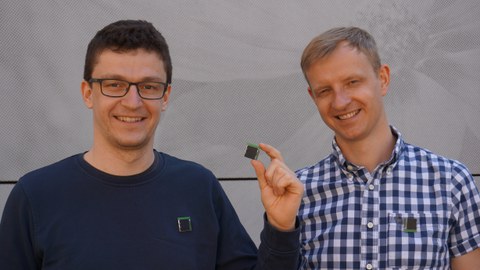Apr 12, 2021
Battery-free Contact Tracing: Fighting the COVID-19 Pandemic with Sustainable Electronics Systems

v.l.n.r.: Kai Geißdörfer und Marco Zimmerling mit den von ihnen entwickeltem Kontaktverfolgungsanstecker bei Infizierung mit COVID-19
Researchers from the Networked Embedded Systems Lab of the Center for Advancing Electronics Dresden (cfaed) at TU Dresden have developed a battery-free electronic device that can be used to automatically identify contacts of a contagious person, without needing to be manually recharged.
Mobile phones, smart watches, tablets, headphones – most of our everyday electronic devices are powered by a battery and must be regularly recharged by plugging them into a power outlet. After some years, the battery is worn out and lasts no longer than a few hours. More often than not, the inconvenience of constant recharging prompts us to purchase a new device because replacing the battery is not economically viable or technically infeasible. Although out of our sight, the disposal of discarded batteries and their toxic substances is extremely expensive and environmentally taxing.
Researchers from TU Dresden envision a future where many of the electronic devices around us operate for decades without a battery and manual recharging. These devices will use environmentally friendly capacitors to buffer energy and extract the energy they need to power themselves from the environment. There is an abundance of ambient energy sources still largely unused, such as light, radio-frequency signals, temperature gradients, and vibrations, to name a few. Tapping into those energy sources and leaving batteries behind has the potential to make electronics and computer systems dramatically more sustainable.
In their latest work, Kai Geissdoerfer and Marco Zimmerling show that battery-free electronics can be used to record and trace human encounters, such as contacts of a person with COVID-19 or other contagious diseases. Their custom-designed devices have the size of a sticker with three solar cells on one side and a tiny 47𝜇F capacitor as energy storage. When attached to people, the devices use the electrical energy generated by the solar cells to exchange radio messages with other devices in the surrounding, and to record every detected contact in flash memory. Indoor and outdoor tests show that new contacts are reliably detected within tens of seconds.
This performance is indeed quite remarkable considering the intermittent operation of battery-free devices: Since the power harvested from ambient sources is often weak, a battery-free device needs to buffer energy before it can wake up and operate for a short period of time. Afterward, the device is forced to become inactive until it has buffered sufficient energy again. Intermittent operation complicates communication between battery-free devices because both sender and receiver must have sufficient energy and become active at the same time to successfully exchange radio messages.
Geissdoerfer and Zimmerling are the first to address this fundamental challenge through the analysis, design, implementation, and experimental evaluation of novel hardware and software mechanisms. Their mechanisms reduce the time needed to mutually detect the presence of all battery-free devices in an area by up to 34.4x compared with the best prior solution. The corresponding research paper will be presented at the 18th USENIX Symposium on Networked Systems Design and Implementation (NSDI), which is one of the two premier international scientific conferences in the area of computer networks and data communications.
